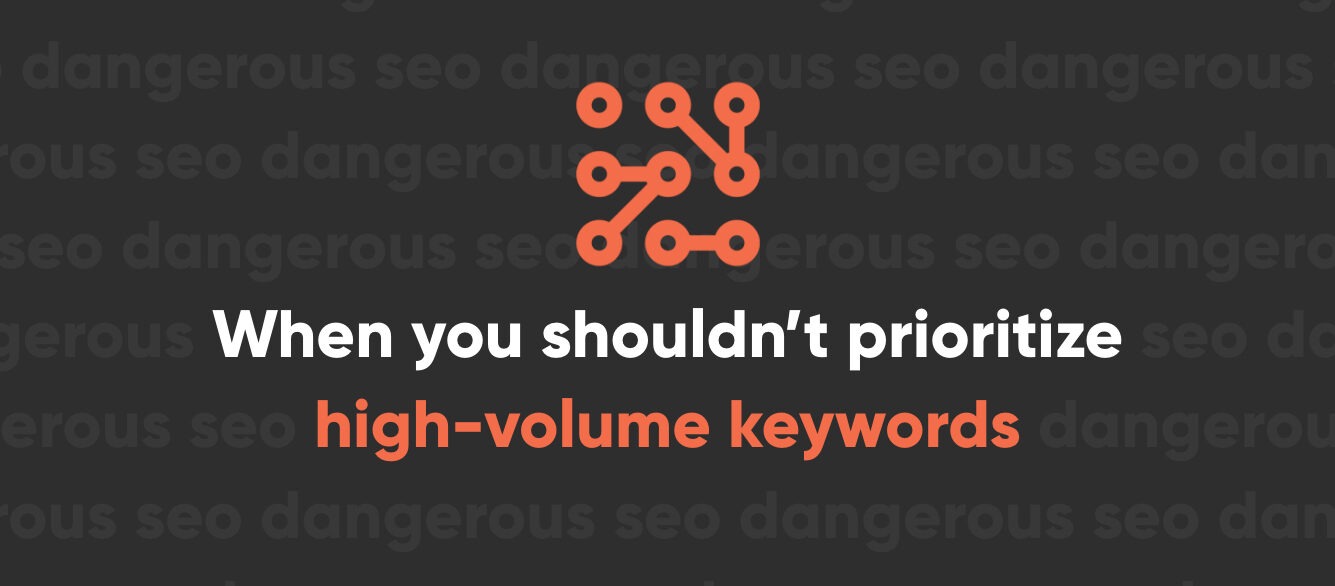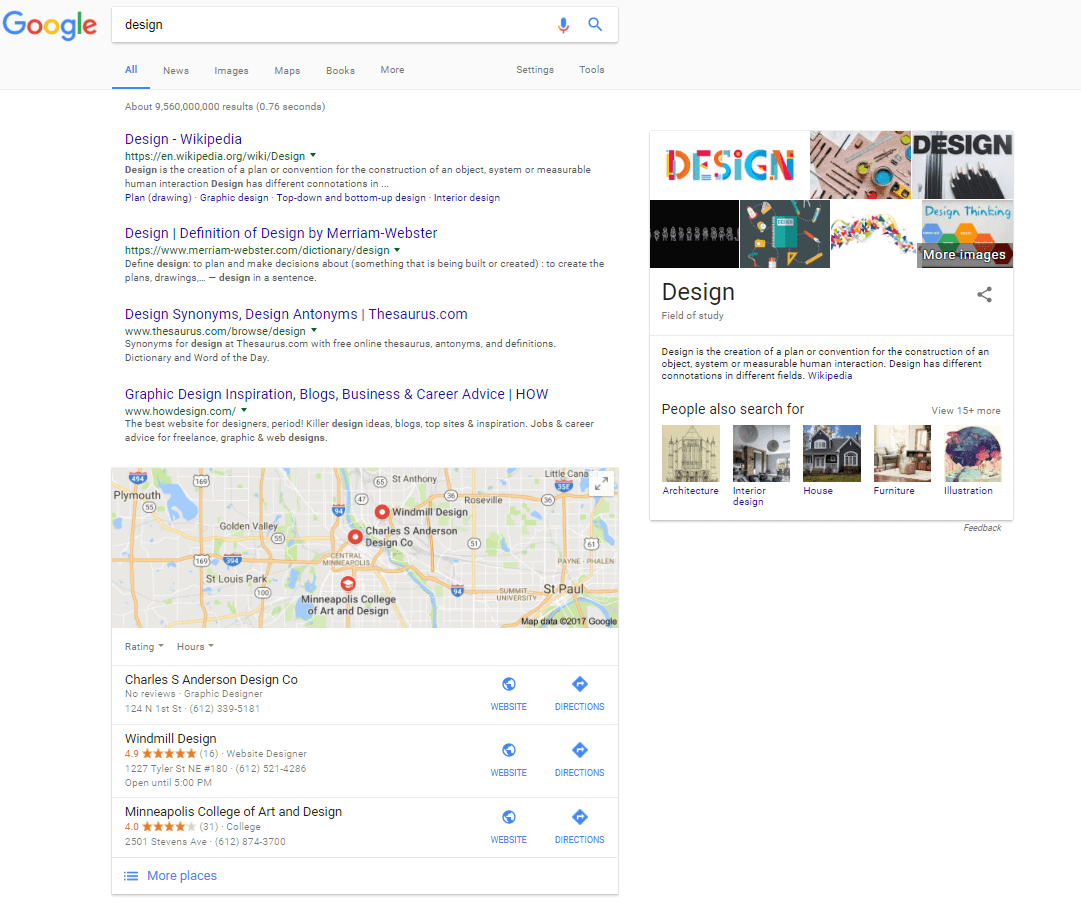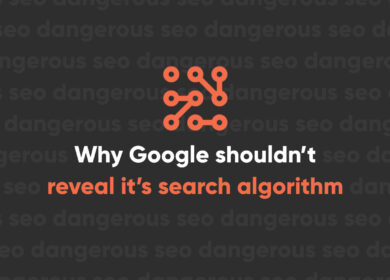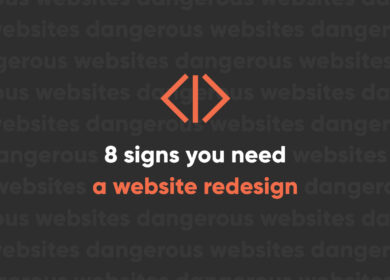
Why You Shouldn’t Always Try to Rank for High-Volume Keywords

Imagine how cool it would be if your website could rank number one for all the biggest keywords in the world. Assuming your hosting provider could accommodate the millions of visitors you’d get every second, you’d be an instant billionaire with all those new customers! Too bad that’s not how SEO works.
Most business owners don’t understand SEO beyond the fact that they know they need it. This lack of knowledge shouldn’t be held against them, but it does create some potential problems for clients who want to “pick their keywords.” Of course they’re going to pick the biggest, broadest, most competitive keywords out there. Oftentimes, this is both impractical, ineffective, and unprofitable.
Are You Sure You Want to Rank for That?
You want to rank for the biggest keywords, right? You know, the ones that will bring the most traffic to your site. Well, let’s consider the keyword “design.” As a web design company, we might want to try to rank for “design.” After all, we design things. On the surface, this might seem like a great idea. Think of all the traffic! But in reality, this is a terrible idea. Here’s why:
Lots of effort, little reward.
“Web design” is competitive enough. If we broaden it to just “design,” then we’re battling with all types of designers. And that’s just the start of it. Ranking for “design” becomes next to impossible, especially since it’s such a high-level query that Google isn’t even sure what you’re looking for if you search for it.

Look at these search results. In the organic listings we have Wikipedia, two different dictionaries, and a graphic design resource website. Then there’s the knowledge panel about design as a field of study (also from Wikipedia). Finally, we have some map listings with a graphic designer, a web designer, and a College design program. It’s quite obvious that Google doesn’t know what you’re looking for, so it’s presenting a wide variety to try to accommodate your needs.
Let’s say you pull off the impossible and dethrone Wikipedia for this particular query. Congratulations! You are obviously really good at SEO. But what will you gain from it? Probably a super high bounce rate, assuming users even bother clicking on your result. People searching for “design” most likely aren’t looking to hire a web design company. They may not even know what they are looking for. This isn’t a query you need to rank for.
Get More Specific
Let’s take a look at another example. Say you’re an engineering firm. You probably want to rank at the top of Google search for “engineering,” right? Well, let’s think about that for a second. Who searches for “engineering”? Probably someone who is trying to figure out what engineering is. It’s an incredibly high-level search that’s most likely not being conducted by someone who wants an engineering job or someone who needs engineering services. And if it is someone who needs engineering services, they have so little knowledge about what they need that you probably aren’t going to want to work with them.
Let’s do one more example. Say you’re a divorce lawyer. Do you want to rank number one for “lawyer”? Not unless you want tons of traffic that has nothing to do with the type of law you practice. So maybe you should rank for “divorce”? That would actually make more sense, but it’s still a little off track. Someone Googling “divorce” isn’t looking for a lawyer. At least not yet. So maybe you should try to rank for something crazy like, I don’t know, “divorce lawyer.”
The downsides of high-volume keywords
High-volume keywords can drive a lot of traffic, but traffic doesn’t mean money for most businesses. Here are some of the downsides of ranking at the top for high-volume keywords:
High Bounce Rate
If your web design company ranks number one for “design,” you’re going to get a lot of bounces. The same is true if your hunting apparel company starts ranking number one for “clothes.” Most people searching for clothes aren’t searching for hunting apparel. Most of them are going to leave your site immediately when they see you don’t meet their needs. You may have generated more traffic, but it was worthless traffic that bounced immediately.

A high bounce rate might not seem like a big deal, but it can have a big negative impact on your data, and there’s also a few theories out there about high bounce rate hurting SEO (that’s a different conversation for a different day). Let’s focus on the data. It’s going to be quite difficult to make accurate observations about your website’s performance with actual potential customers if you have bloated traffic flowing in and out of your site. You may start to think your website is lousy when it’s actually your traffic that’s lousy. But good luck figuring that out.
Bad Inquiries and Wasted Effort
If you increase your traffic, you’re bound to get a few more contact form submissions out of sheer probability. But is that really what you want? No, you want qualified leads. You don’t want to waste your time chasing people who are asking you general questions about your industry. These people aren’t going to convert, and even reading their contact form submissions or listening to their questions is going to take a toll on your sales team. You want to focus your efforts on people who are likely to become your web design customers. Instead of just driving more traffic, you need to drive the right traffic.
Low Conversion Rate
All this extra traffic is going to kill your conversion rate. That might not seem like a problem at first (after all, it’s not like it’s driving down your leads). But what it will do is impact the meaning of your data. How do you know what’s working and what’s not working when your conversion rate is artificially deflated by a bunch of bad traffic? You certainly can’t do much in the way of conversion rate optimization if most of the traffic you’re driving is never going to convert. Now you’re stuck playing guessing games because you have no idea why people aren’t converting.

On the flip side, you don’t want to raise your conversion rate simply by lowering your traffic. What you really want to do is spend your time driving more meaningful traffic that’s more likely to convert, and you want to perform conversion rate optimization to get more of your existing traffic to convert. High-volume keywords don’t let you accomplish either of these things.
What You Really Should Rank For
SEO is not about ranking for everything under the sun and trying to drive as much traffic as possible. It’s about optimizing your website so you show up high in search results for queries that might actually drive some business. That means the focus should be on your brand and the specific services you provide. A web design company should try to rank for “web design,” not general design. And you should want to rank for the services your business performs, not some huge umbrella that your services fall under.
Once you’re dominating the search results for those queries, then you can start chasing some of those broader terms. Just remember that bigger isn’t always better.

Nate Tower
Nate Tower is the President of Perrill and has over 12 years of marketing and sales experience. During his career in digital marketing, Nate has demonstrated exceptional skills in strategic planning, creative ideation and execution. Nate's academic background includes a B.A. with a double major in English Language and Literature, Secondary Education, and a minor in Creative Writing from Washington University. He further expanded his expertise by completing the MBA Essentials program at Carlson Executive Education, University of Minnesota.
Nate holds multiple certifications from HubSpot and Google including Sales Hub Enterprise Implementation, Google Analytics for Power Users and Google Analytics 4. His unique blend of creative and analytical skills positions him as a leader in both the marketing and creative worlds. This, coupled with his passion for learning and educating, lends him the ability to make the complex accessible and the perplexing clear.



